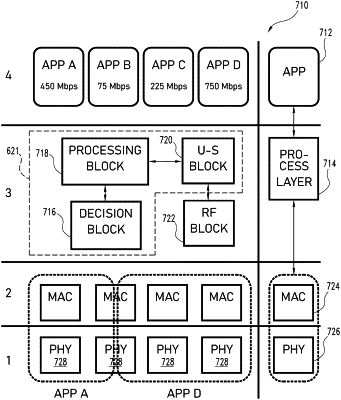| CPC H04W 16/26 (2013.01) | 26 Claims |

|
1. A method of improving the performance of circuitry, comprising the steps of:
providing a processing interface that is adapted to be connected to an application interface of a wireless networking device, the application interface being associated with a first application, the first application providing, after the circuitry has been connected to the application interface and when the wireless networking device is being used, a first data stream and having a first wireless bandwidth requirement;
connecting first, second and third actual MAC interfaces to the processing interface;
connecting first, second and third actual PHY interfaces respectively to the first, second and third actual MAC interfaces;
respectively associating first, second and third wireless transceivers with the first, second and third actual PHY interfaces, wherein each of the first, second and third wireless transceivers is suitable for use in a wireless local area network, and the first, second and third wireless transceivers, respectively, (i) have a first, second and third bandwidth availability up to first, second and third actual bandwidths, and (ii) are adapted to emit radio signals in first, second and third bands of frequencies, at least two of the first, second and third bands of frequencies being different;
forming in the processing interface (i) at least one virtual MAC interface and (ii) at least one resource monitoring interface that, after the circuitry has been connected to the application interface and during operation of the wireless networking device, feed information regarding the bandwidth availabilities of the first, second and third wireless transceivers back to the at least one virtual MAC interface;
wherein the processing interface is configured to, after the circuitry has been connected to the application interface and when the wireless networking device is being used, and in a manner transparent to any layer of the wireless networking device above the processing interface,
(a) request or create (i) a first association between a recipient and the first actual MAC and PHY interfaces, (ii) a second association between the recipient and the second actual MAC and PHY interfaces, and (iii) a third association between the recipient and the third actual MAC and PHY interfaces,
(b) identify at least one first portion of the first actual bandwidth of the first wireless transceiver, the identified at least one first portion comprising a set of given resources,
(c) evaluate whether any of the given resources of the first identified actual bandwidth portion are unavailable for communication,
(d) use the first wireless transceiver to transmit the first data stream to the recipient, without requiring disassociation of the recipient from any of the first, second and third actual MAC and PHY interfaces, using a subset of frequencies corresponding to only the given resources of the first bandwidth portion that are not unavailable for communication to thereby at least partially satisfy the first wireless bandwidth requirement of the first application;
(e) identify at least one first portion of the second actual bandwidth of the second wireless transceiver, the identified at least one first portion of the second actual bandwidth of the second wireless transceiver comprising a set of given resources,
(f) evaluate whether any of the given resources of the first identified actual bandwidth portion of the second wireless transceiver are unavailable for communication, and
(g) use the second wireless transceiver to receive a second data stream from the recipient, without requiring disassociation of the recipient from any of the first, second and third actual MAC and PHY interfaces, using a subset of frequencies corresponding to only the given resources of the first bandwidth portion of the second wireless transceiver that are not unavailable for communication to thereby at least partially satisfy a wireless bandwidth requirement associated with the second data stream; and
wherein, after the circuitry has been connected to the application interface and when the wireless networking is being used, the wireless networking device's utilization of the first available bandwidth portion of the first wireless transceiver does not prevent any wireless networking device from utilizing a range of frequencies corresponding to the remaining portion of the bandwidth availability of the first wireless transceiver for data transmission or reception purposes at the same time that the first bandwidth portion is being used for data transmission purposes; and
wherein, after the circuitry has been connected to the application interface and when the wireless networking is being used, the wireless networking device's utilization of the first available bandwidth portion of the second wireless transceiver does not prevent any wireless networking device from utilizing a range of frequencies corresponding to the remaining portion of the bandwidth availability of the second wireless transceiver for data transmission or reception purposes at the same time that the first bandwidth portion is being used for data reception purposes.
|